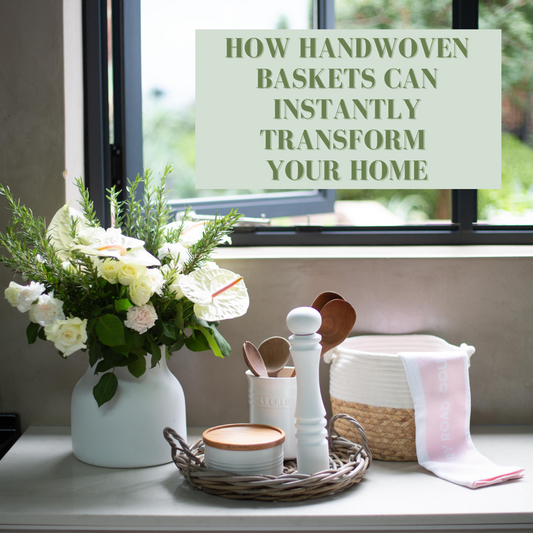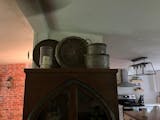
Embracing Biophilic Design: Incorporating Baskets into Your Home Decor
Share
In recent years, biophilic design has gained popularity as a way to create spaces that foster a deep connection with nature. This design philosophy not only enhances aesthetic appeal but also promotes well-being by bringing the outdoors inside. One versatile element that beautifully embodies biophilic design is the basket. Let’s explore how you can incorporate baskets into your home decor to embrace this nature-inspired trend.
What is Biophilic Design?
Biophilic design focuses on integrating natural elements into our built environments. It emphasizes light, space, vegetation, and natural materials to create a calming atmosphere. By enhancing our connection to nature, biophilic design can improve mood, reduce stress, and boost overall well-being.
Why Baskets?
Baskets are a fantastic way to infuse organic shapes, textures, and earthy materials into your decor. They are not only functional but also add warmth and visual interest to any space. Here are some ways to incorporate baskets into your home while aligning with biophilic principles.
1. Natural Materials
Choose baskets made from natural materials like wicker, seagrass, or rattan. These organic textures create a tactile connection to nature. Look for pieces that showcase the craftsmanship and imperfections of natural materials, enhancing their organic appeal.
2. Functional Storage
Use baskets as storage solutions to reduce clutter and maintain a serene environment. Place them in living rooms, bedrooms, or entryways to organize blankets, toys, or shoes. This keeps your space tidy while still maintaining a natural aesthetic.
3. Incorporate Plants
Baskets make excellent planters for indoor plants. Opt for larger woven baskets to house your favorite greenery. Not only does this create a beautiful display, but it also ties in the biophilic element of bringing nature indoors. Consider placing a snake plant, pothos, or fiddle leaf fig in a stylish basket to enhance your space.
4. Layering Textures
Mix and match baskets of different sizes, shapes, and materials to create visual interest. For instance, stack smaller baskets inside larger ones or hang them on the wall as art. This layering not only adds depth to your decor but also mirrors the complexity found in nature.
5. Entryway Solutions
Create a welcoming entryway by using baskets for organization. A large basket can hold shoes, while smaller ones can store keys, mail, or small accessories. This functional approach to decor helps maintain a clutter-free environment, allowing for a more peaceful entry into your home.
6. Dining Table Centerpieces
Use a decorative basket as a centerpiece on your dining table. Fill it with seasonal fruits, fresh flowers, or even candles. This simple addition can enhance your dining experience, bringing a touch of nature to mealtimes.
7. Incorporate Art
Think outside the box! Consider using baskets as wall art. Arrange a series of baskets in various sizes and colors on a wall to create a striking focal point. This unique display not only draws the eye but also adds a natural element to your decor.
8. Textiles and Color
Choose baskets that incorporate natural dyes and colors found in nature. Earthy tones, greens, and warm neutrals complement the biophilic design aesthetic and can harmonize with your overall color scheme.
Incorporating baskets into your home decor is an easy and stylish way to embrace biophilic design. These versatile pieces not only enhance the beauty of your space but also promote a sense of tranquility and connection to nature. Whether you use them for storage, as planters, or as decorative elements, baskets can play a significant role in creating a home that feels both inviting and grounded in nature.
So, go ahead—explore the world of baskets and transform your space into a serene sanctuary that celebrates the beauty of the natural world!
What is Biophilic Design?
Biophilic design focuses on integrating natural elements into our built environments. It emphasizes light, space, vegetation, and natural materials to create a calming atmosphere. By enhancing our connection to nature, biophilic design can improve mood, reduce stress, and boost overall well-being.
Why Baskets?
Baskets are a fantastic way to infuse organic shapes, textures, and earthy materials into your decor. They are not only functional but also add warmth and visual interest to any space. Here are some ways to incorporate baskets into your home while aligning with biophilic principles.
1. Natural Materials
Choose baskets made from natural materials like wicker, seagrass, or rattan. These organic textures create a tactile connection to nature. Look for pieces that showcase the craftsmanship and imperfections of natural materials, enhancing their organic appeal.
2. Functional Storage
Use baskets as storage solutions to reduce clutter and maintain a serene environment. Place them in living rooms, bedrooms, or entryways to organize blankets, toys, or shoes. This keeps your space tidy while still maintaining a natural aesthetic.
3. Incorporate Plants
Baskets make excellent planters for indoor plants. Opt for larger woven baskets to house your favorite greenery. Not only does this create a beautiful display, but it also ties in the biophilic element of bringing nature indoors. Consider placing a snake plant, pothos, or fiddle leaf fig in a stylish basket to enhance your space.
4. Layering Textures
Mix and match baskets of different sizes, shapes, and materials to create visual interest. For instance, stack smaller baskets inside larger ones or hang them on the wall as art. This layering not only adds depth to your decor but also mirrors the complexity found in nature.
5. Entryway Solutions
Create a welcoming entryway by using baskets for organization. A large basket can hold shoes, while smaller ones can store keys, mail, or small accessories. This functional approach to decor helps maintain a clutter-free environment, allowing for a more peaceful entry into your home.
6. Dining Table Centerpieces
Use a decorative basket as a centerpiece on your dining table. Fill it with seasonal fruits, fresh flowers, or even candles. This simple addition can enhance your dining experience, bringing a touch of nature to mealtimes.
7. Incorporate Art
Think outside the box! Consider using baskets as wall art. Arrange a series of baskets in various sizes and colors on a wall to create a striking focal point. This unique display not only draws the eye but also adds a natural element to your decor.
8. Textiles and Color
Choose baskets that incorporate natural dyes and colors found in nature. Earthy tones, greens, and warm neutrals complement the biophilic design aesthetic and can harmonize with your overall color scheme.
Incorporating baskets into your home decor is an easy and stylish way to embrace biophilic design. These versatile pieces not only enhance the beauty of your space but also promote a sense of tranquility and connection to nature. Whether you use them for storage, as planters, or as decorative elements, baskets can play a significant role in creating a home that feels both inviting and grounded in nature.
So, go ahead—explore the world of baskets and transform your space into a serene sanctuary that celebrates the beauty of the natural world!




